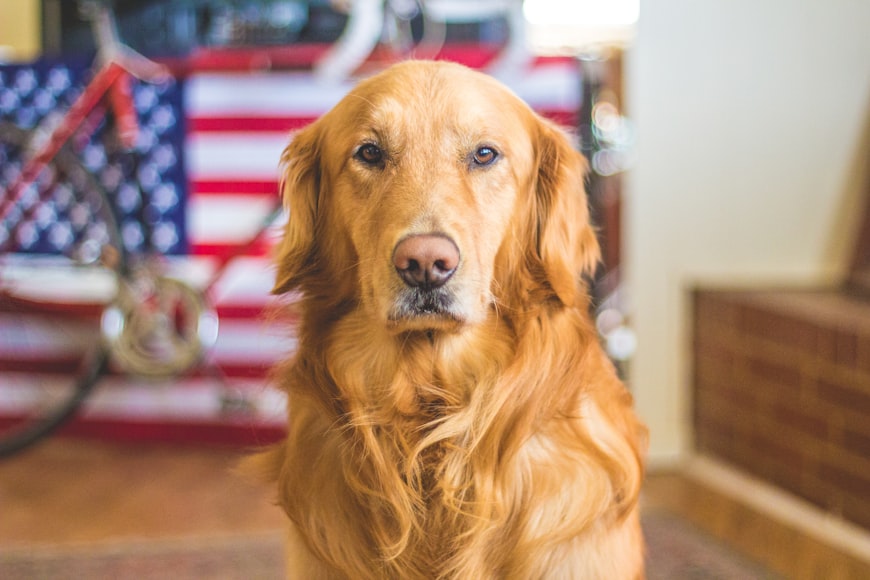How to Stop a Dog from Licking Its Paws

Paw licking is a common issue that affects many dogs. While occasional paw licking is normal, excessive licking can indicate an underlying problem or cause skin irritation. If your dog is licking its paws excessively, it’s important to determine the cause and take steps to stop the behavior.
Causes of Paw Licking in Dogs
Several factors can trigger paw licking in dogs, including:
- Allergies: Contact with allergens, such as pollen, grass, food, or cleaning products, can cause itchy skin and lead to paw licking.
- Bacterial or fungal infections: Bacteria or fungi can infect the skin between the toes or cause nail bed infections, resulting in discomfort and licking.
- Dry skin: Dogs with dry, flaky skin may lick their paws to soothe the itching and irritation.
- Stress or anxiety: Some dogs lick their paws as a coping mechanism for stress or boredom.
- Injuries: Cuts, scrapes, or burns on the paws can cause pain and discomfort, leading to licking.
- Parasites: Fleas and mites can cause intense itching, which may prompt your dog to lick its paws.
- Underlying medical conditions: Conditions such as Cushing’s disease or thyroid dysfunction can cause hormonal imbalances that lead to paw licking.
How to Stop a Dog from Licking Its Paws
Once the underlying cause of the paw licking has been identified, you can take steps to stop the behavior:
- Identify and eliminate allergies: If allergies are the trigger, identify the source and avoid exposure. Use hypoallergenic bedding and cleaning products, and consult your veterinarian about allergy testing.
- Treat infections: Bacterial or fungal infections require veterinary evaluation and antibiotics or antifungals. Keep the affected area clean and dry while administering the medication.
- Moisturize dry skin: Regularly apply a dog-safe paw balm or moisturizer to hydrate and soothe the skin.
- Reduce stress or anxiety: Provide your dog with plenty of exercise, mental stimulation, and companionship. Consider using pheromone diffusers or anxiety wraps to calm them.
- Protect injured paws: Cover any injuries with bandages or booties to prevent further licking and infection.
- Treat parasites: Flea and mite infestations require regular treatment with topical or oral medications. Consult your veterinarian for the most effective choice.
- Rule out underlying medical conditions: If other treatments fail to stop the paw licking, your veterinarian may recommend blood tests or other diagnostic tests to rule out underlying medical conditions.
Home Remedies for Paw Licking
In addition to veterinary treatment, you can try the following home remedies to relieve paw irritation and reduce licking:
- Soak in Epsom salt: Soak your dog’s paws in a lukewarm Epsom salt bath for 10-15 minutes to reduce itching and inflammation.
- Apply apple cider vinegar: Dilute apple cider vinegar with equal parts water and apply it to the affected areas to soothe and disinfect.
- Use tea tree oil: Tea tree oil has antibacterial and antifungal properties. Dilute it with a carrier oil (such as coconut oil) and apply it to the paws before bandaging.
Prevention
To prevent paw licking in the future, follow these tips:
- Keep your dog’s paws clean and dry after walks or playtime.
- Trim your dog’s nails regularly to prevent overgrown nails from causing discomfort.
- Avoid exposure to potential allergens.
- Provide your dog with a healthy diet to promote overall well-being and reduce the risk of skin problems.
- Monitor your dog’s behavior for signs of stress or anxiety, and seek professional help if necessary.
Paw licking is a common problem in dogs, but it’s important to determine the underlying cause to effectively stop the behavior. By addressing allergies, treating infections, reducing stress, and providing proper care for your dog’s paws, you can help alleviate their discomfort and prevent further skin irritation.
Identify the Underlying Cause:

Skin problems are common, affecting people of all ages and backgrounds. While some skin issues are minor and temporary, others can be more serious and require medical attention. When it comes to treating skin problems, identifying the underlying cause is crucial for effective management.
Allergies
Allergies are a common cause of skin problems, such as eczema, hives, and contact dermatitis. Allergens, which can be substances like pollen, dust, or certain foods, trigger an immune system response that causes inflammation of the skin. Symptoms of allergic skin reactions include redness, itching, swelling, and blistering. Identifying the allergen responsible can help reduce exposure and prevent future skin problems.
Parasites
Parasitic infections can also cause skin issues. Parasites, such as scabies, lice, and ringworms, can infest the skin and cause a variety of symptoms, including itching, scaling, redness, and blisters. These parasites can be spread through contact with an infected person or animal or through contaminated clothing or bedding. Proper hygiene and treatment are essential for eliminating parasites and preventing further skin problems.
Injuries
Skin injuries, such as cuts, burns, or abrasions, can disrupt the skin’s natural protective barrier and make it more susceptible to infections and other problems. Injured skin may become red, swollen, and painful. Proper wound care, including cleaning, dressing, and protection from infection, is crucial for promoting healing and preventing complications.
Stress/Anxiety
Stress and anxiety can trigger or worsen certain skin conditions. When the body experiences stress, it releases hormones that can increase skin inflammation and sensitivity. Stress can also lead to poor sleep, which can further contribute to skin problems. Identifying and managing stressors can help reduce skin flare-ups and improve skin health.
Diagnosis and Treatment
To identify the underlying cause of skin problems, healthcare providers will typically perform a physical examination and ask about your medical history, including any known allergies or recent exposure to potential triggers. Additional tests, such as allergy testing, skin biopsies, or blood tests, may be ordered to confirm a diagnosis.
Treatment for skin problems will vary depending on the underlying cause. For allergies, avoiding the allergen and using antihistamines or topical corticosteroids may be helpful. Parasite infections require specific antiparasitic medications. Injured skin requires proper wound care and antibiotics if there is an infection. Stress and anxiety can be managed through therapy, medication, or stress-reducing techniques.
Conclusion
Identifying the underlying cause of skin problems is essential for effective treatment and prevention. By considering potential triggers such as allergies, parasites, injuries, and stress/anxiety, healthcare providers can develop personalized treatment plans that address the root of the problem and improve skin health. If you experience any persistent or severe skin problems, it is important to seek medical attention for a proper diagnosis and appropriate treatment.
Address Underlying Medical Conditions:

Fleas and ticks are common parasites that can affect both pets and humans, causing discomfort, irritation, and potential health concerns. While topical treatments and flea and tick control products play a crucial role in keeping these pests at bay, it’s equally important to address any underlying medical conditions that may contribute to the infestation.
Consult a Veterinarian
The first step towards effectively managing fleas and ticks is to consult a veterinarian. A thorough examination and medical history will help identify any underlying medical conditions that may be attracting or exacerbating the infestation. Common conditions include:
- Allergies: Allergic reactions to food, environmental allergens, or other triggers can cause itching and skin irritation, creating an ideal environment for fleas and ticks.
- Infections: Skin infections, such as bacterial or yeast infections, can also cause itching and inflammation, attracting pests.
- Stress or Anxiety: Excessive stress or anxiety can lead to behavioral changes, such as excessive licking or scratching, which can create open wounds and increase the risk of infection and infestation.
Treat Allergies or Infections
If allergies or infections are identified as the underlying cause of the flea and tick problem, appropriate treatment should be administered. Allergies may require dietary changes, hypoallergenic bedding, or antihistamines. Infections may require antibiotics, antifungal medications, or topical treatments. By addressing the underlying condition, the itching and irritation will be reduced, making the environment less attractive to fleas and ticks.
Manage Stress or Anxiety
In cases where stress or anxiety is a contributing factor, behavioral modification and environmental enrichment strategies can be effective. Providing a safe and comfortable environment, regular exercise, and interactive toys can help reduce anxiety and prevent boredom, which can lead to excessive scratching and licking.
Additional Tips
In addition to treating underlying medical conditions, there are several other measures that can be taken to prevent and manage flea and tick infestations:
- Regular Flea and Tick Prevention: Use flea and tick prevention products as directed by your veterinarian. This may include topical treatments, oral medications, or collars.
- Environmental Control: Vacuum regularly, wash pet bedding and toys frequently, and seal any cracks or crevices where pests may hide.
- Grooming: Brush your pet regularly to remove loose hair and debris that can harbor fleas and ticks.
- Inspect Pets Regularly: Check your pet’s skin and coat for any signs of fleas or ticks. Early detection and removal of parasites is crucial for effective control.
Conclusion
Addressing underlying medical conditions is a critical aspect of effective flea and tick management. By consulting a veterinarian, treating allergies or infections, and managing stress or anxiety, you can create a healthier environment for your pet and reduce the risk of flea and tick infestations. Regular prevention, environmental control, and grooming practices should also be part of a comprehensive flea and tick control program. By taking a holistic approach, you can ensure the health and well-being of your pet while minimizing the nuisance and potential risks associated with these pests.
Provide Relief from Itching and Discomfort:

Itching and discomfort in dogs’ paws can be a common and distressing issue for both the pet and the owner. Understanding the causes and implementing effective remedies can help alleviate the discomfort and improve your dog’s well-being.
Causes of Itching and Discomfort
Various factors can cause itching and discomfort in a dog’s paws, including:
- Allergies: Exposure to environmental allergens, such as pollen, dust, or chemicals, can trigger an allergic response, leading to itching and inflammation.
- Parasites: Fleas, ticks, and other parasites can cause intense itching and irritation by biting and feeding on the skin.
- Bacterial or fungal infections: Cuts, wounds, or other skin injuries can become infected, resulting in itching, redness, and swelling.
- Dry skin: Lack of moisture can cause the skin to become dry, cracked, and itchy.
- Underlying medical conditions: Some underlying medical conditions, such as thyroid issues or autoimmune diseases, can manifest as itching and discomfort in the paws.
Remedies for Itching and Discomfort
Addressing the underlying cause is crucial for long-term relief. However, several practical measures can provide immediate relief from itching and discomfort:
1. Anti-Itch Shampoos and Topical Treatments
Anti-itch shampoos and topical treatments containing ingredients such as oatmeal, aloe vera, or hydrocortisone can help soothe irritated skin, reduce inflammation, and minimize itching. Use these products according to the manufacturer’s instructions.
2. Cold Compresses
Applying cold compresses wrapped in a clean towel to the affected paws can provide cooling relief. The cold temperature helps constrict blood vessels, reducing swelling and inflammation. Apply cold compresses for short periods at a time, avoiding direct contact with the skin.
3. Epsom Salt Soaks
Soaking the dog’s paws in a warm Epsom salt solution can help draw out any toxins, reduce inflammation, and soothe irritated skin. Dissolve about 1/4 cup of Epsom salt in a gallon of warm water and soak the paws for 10-15 minutes.
4. Coconut Oil
Coconut oil has anti-inflammatory and moisturizing properties. Applying a thin layer of coconut oil to the affected paws can help soothe the skin and provide relief from itching.
5. Paw Wax
Paw wax is a protective barrier that can shield the paws from allergens, irritants, and moisture. Applying paw wax before walks or other outdoor activities can help prevent exposure to triggers.
Prevention
Regular preventive measures can help minimize the risk of developing paw problems in dogs:
- Regular grooming: Brush your dog’s paws and trim the nails to remove any debris or allergens.
- Parasite control: Use effective flea and tick prevention treatments to prevent infestations.
- Foot protection: Consider using paw protectors or boots during walks on rough or uneven surfaces.
- Environmental avoidance: Identify and minimize exposure to known allergens or irritants.
Consultation with a Veterinarian
It is important to consult with a veterinarian if your dog experiences persistent or severe itching and discomfort in its paws. The veterinarian can diagnose the underlying cause and prescribe the most appropriate treatment. Home remedies may be insufficient or even harmful in some cases, so seeking professional advice is advisable.
By understanding the causes and implementing effective remedies, you can provide relief from itching and discomfort in your dog’s paws, ensuring their comfort and well-being. Remember to consult with a veterinarian for prompt diagnosis and appropriate treatment to address any underlying medical conditions.
Create a Barrier:

Dogs often lick their paws for various reasons, such as allergies, skin irritations, or underlying medical conditions. While occasional paw licking is normal, excessive licking can lead to irritation, infection, and even behavioral problems. If your dog is excessively licking its paws, it’s essential to seek veterinary advice to determine the underlying cause and receive appropriate treatment.
In addition to addressing the underlying medical issue, creating a barrier on your dog’s paws can help deter them from licking and prevent further irritation. Here are two simple yet effective methods to create a barrier:
1. Wear Booties or Socks on the Dog’s Paws
Booties or socks can act as a physical barrier between your dog’s tongue and its paws. They come in various materials, including cotton, fleece, and neoprene, and can be chosen based on your dog’s comfort and activity level.
To put on booties or socks, follow these steps:
- Place the dog’s paw into the bootie or sock, ensuring that it fits snugly but not too tightly.
- Pull the bootie or sock up over the paw, covering the entire area that the dog typically licks.
- Secure the bootie or sock with any straps or fasteners provided.
Booties or socks can be worn for short periods to prevent paw licking. However, they should not be left on for extended periods as they can restrict the dog’s movement and circulation.
2. Apply Bitter Spray or a Topical Paw Balm
Bitter sprays or topical paw balms contain non-toxic ingredients that taste bitter to dogs. When applied to the dog’s paws, these products deter the dog from licking by creating an unpleasant sensation in its mouth.
When using bitter spray or paw balm, follow these instructions carefully:
- Test the product on a small area of your dog’s skin before applying it to its paws. This will ensure that the product does not cause any allergic reactions.
- Apply the product to the areas of the paws that the dog typically licks. Avoid getting the product into the dog’s eyes, nose, or mouth.
- Allow the product to dry completely before allowing your dog to walk or lick its paws.
Bitter sprays or paw balms can be applied as needed to deter paw licking. However, it’s important to avoid using these products excessively, as they can irritate your dog’s skin.
Creating a barrier on your dog’s paws can be an effective way to reduce paw licking and promote healing. However, it’s important to remember that these methods are temporary solutions and should not be used as a substitute for addressing the underlying cause of the paw licking. If your dog is excessively licking its paws, consult with your veterinarian to determine the underlying cause and receive appropriate treatment.
Distract and Redirect:
Unwanted behaviors in dogs can be a source of frustration for pet owners. However, with the right strategies, it is possible to effectively manage these behaviors and promote a harmonious relationship with your furry companion. One proven approach is to implement the “Distract and Redirect” technique.
Understanding Distract and Redirect
Distraction and redirection involves introducing a positive stimulus to divert the dog’s attention from an unwanted behavior and redirect it towards an appropriate activity. By doing so, you can break the cycle of repetitive or disruptive actions and encourage alternative behaviors.
Implementing the Technique
Applying the distract and redirect technique requires consistency and patience. Here are two effective ways to go about it:
1. Provide Toys or Interactive Games:
- When your dog engages in an unwanted behavior, immediately offer them a favorite toy or start an interactive game.
- Engage them in a fun activity, such as fetch, tug-of-war, or hide-and-seek.
- The toy or game will distract your dog from the unwanted behavior and provide a positive outlet for their energy.
2. Engage in Training Exercises:
- If your dog has a specific unwanted behavior, such as excessive barking or jumping on people, use training exercises to redirect their actions.
- Begin by teaching your dog basic commands like “sit,” “stay,” and “down.”
- When your dog starts to exhibit the unwanted behavior, give the appropriate command and reward them with a treat when they obey.
- Over time, your dog will learn to associate the unwanted behavior with a negative consequence (not getting a treat) and the desired behavior with a positive reward (receiving a treat).
Benefits of Distract and Redirect
The distract and redirect technique offers several benefits, including:
- Reduces Unwanted Behaviors: It effectively diminishes the frequency and intensity of problematic behaviors.
- Promotes Positive Reinforcement: Focuses on rewarding desired behaviors, strengthening the bond between owner and dog.
- Encourages Alternative Activities: Provides alternative outlets for the dog’s energy and mental stimulation.
- Improves Communication: Enhances communication between owner and dog by establishing clear expectations and boundaries.
Tips for Success
- Consistency is Key: Be consistent in using the technique every time the unwanted behavior occurs.
- Patience and Repetition: It takes time and patience for dogs to learn and change their behavior.
- Avoid Punishment: Punishment can deter your dog from engaging in the unwanted behavior, but it will not encourage positive behavior change.
- Identify Triggers: Observe your dog’s behavior and identify the triggers that lead to the unwanted behavior. This will help you prepare and prevent situations that may elicit negative reactions.
- Seek Professional Help: If you are experiencing difficulty managing your dog’s unwanted behavior, consider seeking professional guidance from a certified dog trainer or animal behaviorist.
Conclusion
Distract and redirect is a highly effective technique for managing unwanted behaviors in dogs. By providing alternative stimuli and reinforcing desired actions, you can redirect your dog’s focus and promote harmonious behavior. With patience, consistency, and positive reinforcement, you can create a positive and rewarding relationship with your beloved canine companion. Remember that the key to success lies in identifying the triggers, providing appropriate distractions and redirections, and maintaining a consistent and patient approach.
Use a Bitter Deterrent:
When it comes to addressing undesirable behaviors in dogs, positive reinforcement and training should always be prioritized. However, there are situations where an additional deterrent can provide support and hasten the training process. One effective method is the use of a bitter deterrent.
What is a Bitter Deterrent?
A bitter deterrent is a spray or solution that produces a foul taste when applied to an object or surface. Dogs have highly sensitive taste buds, and the unpleasant flavor of the deterrent acts as a deterrent against chewing, licking, or biting.
Application of a Bitter Deterrent
To effectively deter specific behaviors, follow these steps:
- Identify the problem area: Determine where the dog is engaging in the unwanted behavior, such as chewing furniture or licking paws.
- Apply the deterrent: Generously spray or apply the bitter solution to the targeted area. Ensure thorough coverage to prevent any missed spots.
- Repeat as necessary: If the dog attempts to engage in the behavior again, repeat the application process until the desired result is achieved.
Benefits of Using a Bitter Deterrent
- Safe and non-toxic: Most bitter deterrents are specially formulated for dogs and are safe for use around pets.
- Effective: The unpleasant taste of the deterrent effectively discourages dogs from chewing, licking, or biting.
- Temporary solution: Bitter deterrents provide a temporary solution while the dog undergoes training and behavioral modification.
- Supports positive reinforcement: Used in conjunction with positive reinforcement techniques, a bitter deterrent can reinforce desired behaviors by making undesirable actions less appealing.
Cautions and Considerations
While bitter deterrents can be an effective tool, there are certain precautions to consider:
- Avoid ingestion: Some dogs may attempt to ingest the deterrent, which could lead to digestive issues. If you suspect your dog has ingested the detergent, contact your veterinarian immediately.
- Test before use: Always test the deterrent on a small area of your dog’s skin before applying it more broadly. This helps prevent any allergic reactions.
- Use with caution on delicate areas: Avoid applying bitter deterrents to your dog’s eyes, ears, or genital areas.
- Keep out of reach of children: Store bitter deterrents securely to prevent accidental exposure or ingestion by children.
Conclusion
A bitter deterrent can be a valuable tool in addressing destructive dog behaviors. By applying the deterrent to targeted areas, you can effectively discourage your dog from chewing, licking, or biting. However, it’s essential to use the deterrent cautiously, avoid ingestion, and continue with positive reinforcement training to achieve lasting behavioral improvements.
Consider a Cone:
Dogs, with their curious nature and boundless energy, often find themselves in situations that can lead to injuries or discomfort. One such situation is when they develop an itch or irritation on their paws, which they may attempt to alleviate by licking or chewing. While this may seem like a natural instinct, it can worsen the issue and even introduce infection.
To prevent your furry companion from reaching their paws and potentially exacerbating the problem, it is essential to consider the use of an Elizabethan collar, commonly known as a cone. This device, resembling an Elizabethan-era ruff, serves as a physical barrier that restricts the dog’s access to its paws and other areas it should not be touching.
Benefits of Using a Cone:
- Prevents Paw Licking: The primary purpose of a cone is to prevent your dog from licking or chewing its paws, which can aggravate itching, irritation, or wounds. By keeping the paws protected, the cone provides a conducive environment for healing.
- Protects Wounds: In cases of wounds or surgical sites on the paws, a cone is invaluable in keeping the area clean and free from infection. Licking or chewing can dislodge stitches or disrupt the healing process, leading to complications.
- Reduces Self-Mutilation: Some dogs, when distressed or anxious, may resort to self-mutilation by excessively licking or chewing their paws. A cone can help break this negative cycle and prevent further damage to the paws.
- Allows for Medication Absorption: If your dog has a skin infection or other condition that requires topical or oral medication, a cone can ensure that the medication is not licked off prematurely, allowing for effective absorption.
Choosing and Using a Cone:
- Size and Fit: Selecting the appropriate size cone is crucial. A cone that is too small may not provide adequate coverage, while a cone that is too large can be cumbersome for the dog. Ensure the cone extends beyond the dog’s nose to prevent it from reaching its paws.
- Material: Cones are typically made from plastic or soft, flexible materials. Plastic cones are more durable but can be noisy and uncomfortable. Soft cones are more comfortable but may not provide the same level of protection.
- Comfort: It is essential to make sure the cone is comfortable for your dog. Adjust the strap to ensure a snug but not constricting fit. Pad the edges of the cone with soft material to prevent chafing or irritation.
- Monitoring and Supervision: While using a cone, it is essential to monitor your dog closely, especially during the initial stages. Ensure they can drink, eat, and move around comfortably. Supervise them to prevent them from accidentally bumping into objects or getting tangled in the cone.
Alternatives to a Cone:
While cones are generally the most effective method of preventing paw licking, there are alternative options to consider in specific situations:
- Paw Bandages or Wraps: These can be useful for covering minor wounds or protecting paws from environmental irritants.
- Bitter Apple Spray: Applying a bitter substance to the dog’s paws can deter them from licking or chewing. However, this method may not be suitable for all dogs.
- Anti-Licking Devices: These specialty devices can be attached to the dog’s collar and emit a citronella scent when licking is detected.
Conclusion:
An Elizabethan collar (cone) is an invaluable tool for preventing dogs from reaching their paws and exacerbating conditions such as itching, irritation, or wounds. By providing a physical barrier, cones allow for proper healing, reduce pain, and protect the dog’s overall well-being. Choosing the appropriate cone, ensuring comfort, and monitoring the dog while wearing it are essential for optimal outcomes. If you are concerned about your dog’s behavior or skin condition, consult with your veterinarian for personalized advice and treatment options.
Maintain Cleanliness:
Maintaining the cleanliness of your canine companion is not only crucial for their well-being but also plays a significant role in preventing certain health issues. Two key elements of cleanliness include keeping their paws clean and trimming overgrown nails.
Keep Your Dog’s Paws Clean
Dogs’ paws are exposed to various germs, allergens, and contaminants during their daily walks and explorations. It is essential to make a habit of wiping their paws daily, especially after outdoor activities. This simple step helps prevent the spread of bacteria and other microorganisms into the home and onto furniture.
To clean your dog’s paws, use a damp cloth or pet-safe wipes designed for paw cleaning. Gently wipe away any dirt, debris, or moisture. Pay attention to the areas between the toes, where dirt and small objects can often get stuck.
Regular paw cleaning is vital for dogs with skin allergies or sensitivities, as even small irritants can trigger discomfort and itching. Additionally, keeping paws clean reduces the risk of foot infections and nail bed infections.
Trim Overgrown Nails
Overgrown nails can cause discomfort, interfere with walking, and even lead to injuries. Regularly trimming your dog’s nails prevents these issues and maintains their overall foot health.
To trim your dog’s nails, you will need a pair of pet nail clippers specifically designed for dogs. Gently hold your dog’s paw and locate the quick, which is the pink part of the nail containing blood vessels and nerves. Avoid cutting the quick, as it can cause pain and bleeding.
If you are not comfortable trimming your dog’s nails yourself, it is advisable to seek the assistance of a veterinarian or professional groomer. They have the experience and equipment to perform safe and effective nail trims.
Signs of Nail Overgrowth
Here are some signs that indicate your dog’s nails are overgrown:
- Nails are visibly long and curl or curve
- Nails touch or overlap the floor when the dog is standing
- The dog shows signs of discomfort while walking or scratching
- Nail beds become inflamed or show signs of infection
Importance of Cleanliness for Overall Health
Maintaining cleanliness is not just about keeping your dog looking its best. It plays a crucial role in their overall health and well-being. Regular paw cleaning and nail trimming prevent the spread of infections, reduce discomfort, and promote general foot health.
Furthermore, a clean environment reduces the risk of allergies, skin problems, and other health issues. By taking the necessary steps to keep your dog clean, you can contribute to its longevity and enhance its quality of life.
Conclusion
Maintaining the cleanliness of your dog is an essential part of responsible pet ownership. By following simple daily habits like wiping their paws and trimming their nails, you can help prevent health problems, promote comfort, and ensure your canine companion lives a happy and healthy life. Remember to consult with a veterinarian or professional groomer if you have any concerns or need assistance with these tasks.
Manage Stress and Anxiety:
Stress and anxiety are common issues among pets, often leading to behavioral problems and health concerns. As responsible pet owners, it’s essential to understand the causes and symptoms of stress in our furry companions and take proactive steps to mitigate it.
Identifying and Addressing Stressors
The first step in managing stress is identifying its source. Common stressors for pets include:
- Environmental changes: Moving, renovations, or introducing new pets or people
- Separation anxiety: Being left alone for extended periods
- Loud noises: Fireworks, construction, or thunderstorms
- Medical conditions: Pain, illness, or changes in mobility
- Confinement: Being restricted to small spaces or on leashes for long periods
Once you’ve identified the stressors, take steps to minimize their impact:
- Provide a safe haven: Create a designated quiet space for your pet where they can retreat during stressful situations.
- Establish a routine: Stick to regular mealtimes, walks, and play sessions to provide predictability and a sense of control.
- Exercise: Regular physical activity helps burn off excess energy and reduce anxiety.
- Socialization: Engage your pet in positive interactions with other animals and people to build their confidence.
- Consider calming aids: Diffusers releasing pheromones or music with soothing melodies can help create a calming environment.
Providing a Calm and Safe Environment
In addition to addressing stressors, it’s crucial to provide a calm and safe environment for your pet:
- Create a peaceful home: Avoid loud noises, excessive clutter, or sudden movements.
- Ensure ample space: Allow your pet to move around freely and have dedicated areas for eating, sleeping, and playing.
- Provide hiding places: Offer secluded spots where your pet can retreat when feeling stressed or overwhelmed.
- Avoid punishment: Negative reinforcement only worsens anxiety and can damage the bond between you and your pet.
Consulting a Veterinarian for Anti-Anxiety Medication
In severe cases of anxiety, consulting a veterinarian may be necessary. They can prescribe anti-anxiety medications, such as benzodiazepines or selective serotonin reuptake inhibitors (SSRIs), to reduce stress levels.
Anti-anxiety medication is typically used in conjunction with behavioral therapy and environmental modifications. It’s essential to follow the veterinarian’s instructions carefully and monitor your pet’s response to the medication.
Symptoms of Stress and Anxiety
Recognizing the signs of stress and anxiety in pets is crucial for prompt intervention:
- Behavioral changes: Hiding, pacing, excessive barking or meowing, aggression
- Physical symptoms: Increased heart rate, panting, dilated pupils, drooling
- Health concerns: Digestive problems, skin issues, weight loss
Conclusion
Stress and anxiety can significantly impact the well-being of our pets. By understanding the causes, identifying stressors, and providing a calm and safe environment, we can help alleviate their anxiety and improve their overall health and happiness. If necessary, consulting a veterinarian for anti-anxiety medication can provide additional support in managing severe cases of anxiety. Remember, our pets rely on us for their care and comfort, and it’s our responsibility to ensure their emotional well-being.






















